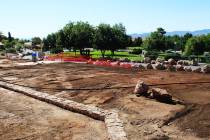Deal inked to conserve Colorado River water
Water suppliers from the four largest communities served by the Colorado River have finalized an $11 million agreement to prop up the drought-stricken river by paying cities, farms and industrial operations to cut their use.
The U.S. Department of Interior announced completion of the deal July 31. The Southern Nevada Water Authority board signed off on its role in April.
The Colorado River System Conservation Program will be seeded with $2 million each from the water authority, the Central Arizona Water Conservation District, the Metropolitan Water District of Southern California and Denver Water. Another $3 million will come from the Bureau of Reclamation, the federal agency that oversees the river and many of its dams.
Starting next year, the money will be used to help cities, farms, factories and power plants pay for efficiency improvements and conservation measures to cut river water use. Any water saved will be kept in the river to help bolster Lake Mead and Lake Powell, the Colorado’s two largest reservoirs.
Lake Powell is about half full, while Lake Mead now sits at less than 39 percent of capacity, its lowest level since it was filled for the first time in 1937.
Water managers have joined before to fund conservation measures on the Colorado, but they always did so in exchange for a direct share of the savings. Under this pilot program, the only beneficiary is the river itself.
When the program was approved by the water authority earlier this year, general manager John Entsminger said he hopes to see it expand and change as needed during its first few years.
In a statement last week, U.S. Deputy Secretary of the Interior Mike Connor called the agreement “a critically important first step” by municipal water providers to address “the imbalance in supply and demand on the Colorado River that could seriously affect the economy and the people who rely upon the river.”
Boulder City gets 97 percent of its water from the Colorado River by way of Lake Mead, while Las Vegas Valley gets 90 percent of its drinking water from the river. The river supplies water to about 40 million people and irrigates several billion dollars worth of crops in seven Western states and parts of northwestern Mexico.
The Colorado has seen below-average flows in 10 of the past 15 years, marking the driest such period in roughly a century of record keeping.
Contact Henry Brean at hbrean@reviewjournal.com or 702-383-0350. Follow @RefriedBrean on Twitter.











